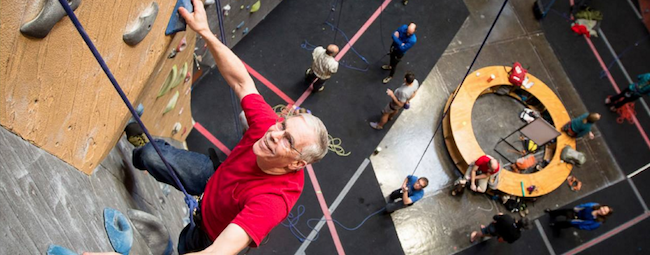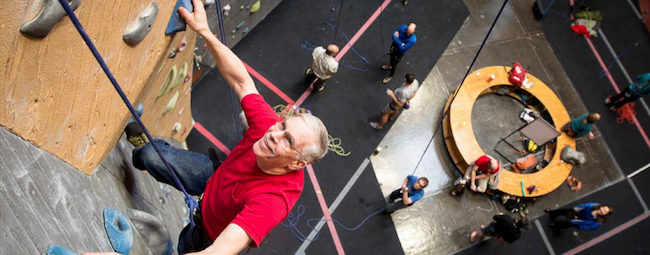
By Jack Simonson
Climbing is geared towards the young and unruly. The history of our sport lends credibility to this notion: Yosemite renegades in the 70s; brightly colored spandex-clad sport climbers out at Smith Rock in the 80s; the emergence of bouldering as a discipline in its own right in the 90s; and the booming competition scene in the 2000s; all of this dominated by younger climbers in their 20s and 30s. Older climbers have always been around, and often have continued to push limits in the sport (Yuji Hirayama comes to mind), but they are in the minority.
Indoor climbing, in particular, has been dominated by younger crowds. For example, at this year’s USAC Open Bouldering Nationals, five of the top ten women and four of the top ten men, including both national champions, were youth competitors aged 18 or under. Each year, events like these seem to be become even more crowded with young talent.
While climbing may seem a young person’s sport on the face of it, climbing truly is a lifelong sport and an activity for all ages. Part of the allure of climbing is that there is something offered for people of all abilities and sizes. You can be 14 and climb V10 or 75 and climb 5.6, it doesn’t matter as long as you’re participating. Indoor climbing has begun to market itself as a place for all people to enjoy climbing, no matter how they do it, and part of this marketing is directed specifically at older customers who are new to the sport. Older customers can provide a sizeable pool of potential members, and gyms looking to increase their membership numbers and diversify their clientele can look to the senior population.
The Over 55 Set
According to Stella Moll-Nevins, Program Director for Vertical World, members 55 and older in Vertical World gyms make up only approximately 5% of their total membership. These numbers are not reflective of the percentage of the population comprised by those 55 and older, so what is holding back older climbers from participating in indoor climbing?
“People who didn’t start young can often feel too intimidated or discouraged to try it at a later age,” Moll-Nevins says. “Any older adults have the physical ability to rock climb, as well as the available means and time. All that remains is for us to effectively reach out and invite them in.”
Many gyms around the country offer discounts for seniors in order to help incentivize them, but by developing programming designed specifically for older climbers, gyms could see a real difference in their number of senior members.
Vertical World in Seattle has begun to offer a program called “Over the Mountain … and Beyond” which, according to Moll-Nevins, is geared toward people 55 and older with little or no experience with climbing. This program offers multiple beginner-level classes that older climbers who are new to the sport can sign up for. The goal of these courses is to, “Teach them to be self-sufficient in a top-rope indoor climbing setting,” says Moll-Nevins.
In our interview, Moll-Nevins stated that part of what makes Over the Mountain great for seniors is not just restricting the age limit for participation, but designing the program around senior’s specific needs. “Classes take place in the middle of the day, when there are fewer distractions and no other organized events happening in the gym,” she explains. Offering classes for older climbers in a low-key, less intimidating setting could be helpful in encouraging those who are hesitant to make the decision to try climbing. By teaming up with senior centers and other groups aimed at keeping the older population active, Vertical World is looking to encourage older customers who are new to climbing to join in on the fun and reap the benefits of maintaining an active lifestyle.
Warehouse Rock Gym in Olympia, WA has taken a slightly different approach in order to engage their older members. Warehouse is an active participant in the Washington State Senior Games, a multi-event competition aimed at getting people over 50 out and active. According to the WSSG website, “The purpose of the Washington State Senior Games is to keep seniors healthy and productive … The event assists in maintaining a healthy lifestyle and promotes positive healthy activities for the participants, their families and the communities where they live.”
As a host member of the Games, Warehouse Rock Gym provides an opportunity for seniors to compete in indoor climbing in a friendly, welcoming environment. By participating in the Senior Games, WRG is opening up indoor climbing to new customers as well as providing older members with a competition that is run specifically for them. Esteban Pinto, Operations Director for WRG, says, “It’s a lot of fun for our senior climbers that don’t take part in any of our competitions throughout the year. It’s really nice to see those members especially get excited and train for this event which is just for them.”
Aging Well
Perhaps one of the best ways for indoor climbing to market itself towards seniors is to emphasize the health benefits of physical activity. According to the National Institutes of Health, “When older people lose their ability to do things on their own, it doesn’t happen just because they’ve aged. It’s usually because they’re not active … becoming active on a regular basis will give you more energy and the ability to do things more easily, faster, and for longer than before.”
Being active can be beneficial for seniors’ mental health as well as for their physical health. The NIH claims that “regular, moderate physical activity can help manage stress and improve your mood … help reduce feelings of depression [and] can improve or maintain some aspects of cognitive function.”
Specifically, the NIH recommends that seniors engage in activities that target endurance, strength, balance, and flexibility. Any climber knows that these four areas are all required by climbing, whether it is indoors or outdoors, and that one can maintain their mobility or improve in these areas by climbing regularly.
In order to engage new members who are part of the older demographic, climbing gyms can focus on providing programming and climbing education that is designed specifically for older adults. Climbing can be intimidating for those who are new to the sport, and especially for seniors who may not feel as spry as they once did. Yet by providing classes and events specifically for older adults, climbing can begin to be seen as a sport that is welcoming to all.
The NIH encourages seniors to become active at any age: “Even if you think you’re too old or too out of shape to exercise … it’s never too late to start.” By marketing climbing as an activity for both social enjoyment and as a healthy way to stay active in one’s golden years, gyms may begin to see a rise in the number of their senior members. Encouraging seniors to take up climbing can also help gyms demonstrate that their industry is capable of being a welcoming place for people of all ages, sizes, and abilities, making climbing an even more marketable activity, increasing its visibility in a crowded fitness and health-oriented marketplace.

Climbing Business Journal is an independent news outlet dedicated to covering the indoor climbing industry. Here you will find the latest coverage of climbing industry news, gym developments, industry best practices, risk management, climbing competitions, youth coaching and routesetting. Have an article idea? CBJ loves to hear from readers like you!







